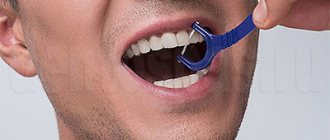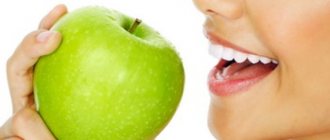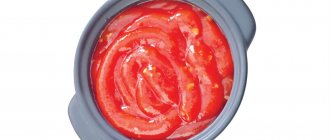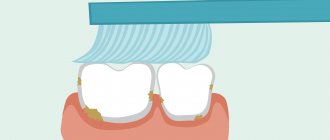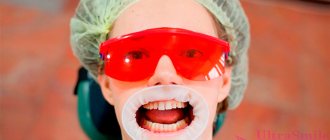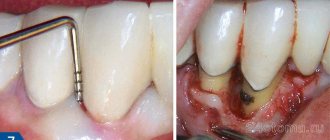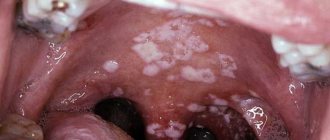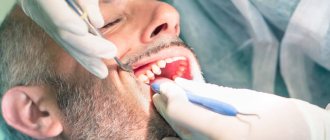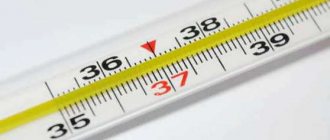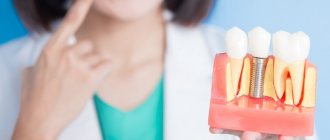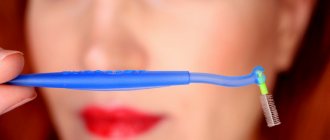General rules for dental care after ultrasonic cleaning
By resorting to the rules developed by dentists, it is easy to achieve a long-lasting effect after cleaning the dental plate. These include:
- To prevent the deposition of stones and plaque on teeth, visit a doctor every 6 months.
- The doctor, after examining the oral cavity, will give an opinion on the possibility or impossibility of a procedure using laser beams.
- When a pathological process is identified, the doctor first eliminates it: caries or something else.
- After laser cleaning, 2-3 weeks should pass. Products that affect the color of the enamel are excluded from the diet during the recovery period.
- Whitened fangs, molars and incisors are also susceptible to mechanical stress. In this regard, nuts, seeds and even chips are removed from the diet for 7-20 days.
By applying the rules in practice, it is easy to avoid damage to the tooth plate and gums that have not had time to recover.
Why do you need a diet?
The teeth whitening procedure involves influencing the natural or acquired shade of enamel with a special device or means for “evaporating” the dark pigment.
Subsequently, the protective layer of enamel becomes thinner. It takes about 10–14 days for it to fully recover. If the still fragile tooth enamel can be affected by dyes, then there is a high probability of staining the surface of the teeth. To prevent this result, dentists have developed a special white diet that excludes a number of “colored” foods from the diet.
Before the procedure or after its completion, the dentist gives the patient the necessary recommendations about acceptable and prohibited products after teeth whitening. Neglecting the recommendations can cause not only darkening of the enamel, but also the development of caries.
Allowed products after the procedure
In addition to your favorite treats and drinks that require exclusion for up to 3 weeks, there are healthy foods:
- The meat is fatty and dietary. Steamed cutlets, goulash, and stewed cabbage rolls are suitable.
- Garnish with mashed potatoes, rice, oatmeal, pasta.
- Soups and meat broths of different consistencies.
- From fermented milk products: sour cream, yogurt without dyes, non-sour cottage cheese, milk.
- Fruits that do not leave a tint, vegetables without acid - zucchini, white cabbage and beans, potatoes.
- Still drinks, diluted juice.
- Bread of any kind, without a hard crust.
- Soft confectionery products: pastries, cakes, marmalade, marshmallows.
- Eggs are allowed in any type of preparation.
Monitor the temperature of the prepared foods; they must be warm when eaten.
Which products are safe
Dentists recommend consuming foods that are not only safe, but also healthy for your teeth. It is advisable to include foods containing minerals (calcium and fluorine) as well as vitamins (A, EC) into your daily diet. Quick fastening of the enamel will allow you to quickly return to your usual diet and favorite dishes.
Experts determine the main list of foods that can be eaten after teeth whitening at the dentist:
- any dairy products that do not contain dyes or coloring fillers;
- fruits and vegetables of dull colors;
- natural seafood;
- poultry and egg whites;
- pasta, cereals and potatoes;
- any cabbage, with the exception of red cabbage;
- bakery products;
- celery or asparagus (steamed).
When following a white diet after teeth whitening, the list of acceptable foods includes all those foods that do not have a coloring effect.
It is recommended to adhere to these particular products in order to avoid not only staining, but also damage to the enamel. Weakened enamel can react to sour, salty and spicy foods, which will “eat away” the unprotected enamel, thus provoking the development of infectious or inflammatory processes. It is also not advisable to consume rough food to prevent damage to the surface of the teeth.
Prohibited products after cleaning the stone
Products with dyes, sour and hard products are strictly excluded. Professional hygiene requires limiting the following range of products:
- black tea and coffee, hot chocolate and cocoa, fruit juice, compote and carbonated drinks;
- sour first courses (tomato soup and borscht, beetroot soup);
- buckwheat;
- black bread;
- fruits with bright juice, these include: currants, strawberries, mulberries, raspberries, pomegranates, cherries;
- sour citrus fruits;
- sauces, vinegar and mustard are added to them;
- dark chocolate, jam, colored sweets.
Acidic, sticky and viscous substances prevent the enamel and gums from recovering after hygiene procedures during the prescribed period.
We keep it clean!
Both after whitening and after professional hygienic teeth cleaning with ultrasound, tooth sensitivity increases, although in the case of ultrasound cleaning, unpleasant painful sensations do not occur as often and are not as pronounced. Therefore, in order to protect yourself from possible discomfort, you need to reconsider your usual diet and temporarily exclude hot, cold, sour, salty, and sweet dishes from the menu.
In addition, for the first week after removing soft dental deposits and removing tartar, you should stop smoking and consuming any foods and drinks that have coloring properties. The list of foods that should be excluded from the diet includes berries (blackberries, blueberries, black grapes and currants), vegetables (carrots, beets, tomatoes, pumpkin, red cabbage, etc.), drinks (black tea, coffee, chocolate , cocoa, lemonades and carbonated sweet drinks), juices with the addition of natural and artificial colors.
The specialists of our dental clinic recommend that all patients, after professional teeth cleaning, be sure to adhere to the rules of thorough oral hygiene - if possible, brush your teeth after every meal or use special hygiene devices (toothpicks, floss, etc.).
Beverage requirements
Do not be upset if the doctor tells you to prohibit certain drinks. Remove from those previously used with a coloring pigment and a high acid concentration.
What about tea?
Black tea is definitely not allowed, it provokes dark plaque on healthy teeth. What can we say about recently processed ones that require gentle treatment. Green tea, despite its many beneficial properties, is also not allowed - tannins leave a yellowish tint on the enamel surface.
Should I drink coffee?
In the first week, you need to come to terms with the state of things and give up coffee. The yellow pigment produced by caffeine will immediately be deposited on the teeth. Next, if patience has run out, drink a weak coffee drink, no more than once a day. But it is still better to endure a period of rehabilitation of the surface of the enamel and periodontal tissue.
Alcoholic drinks
Dentists do not express categorical prohibitions against strong drinks without dyes. But any of them cannot be drunk from the refrigerator - the enamel cannot withstand such a load and will crack. Beware of wines, they contain different types of dyes.
Tobacco products
In addition to the fact that smoking is harmful to health, tobacco also has a negative effect on your teeth. Resins cling to the top surface of the plates, forming a yellow coating. Bone tissue is gradually destroyed due to a decrease in beneficial bacteria. In other words, the microflora of the oral cavity noticeably deteriorates.
Other recommendations
Professional whitening in order to prevent negative consequences requires special dental care, which is not limited only to a white diet.
Dentists advise patients to adhere to several rules in the first two weeks:
- oral hygiene should be gentle (select a brush with soft bristles, a toothpaste without abrasive particles, use rinses, refuse irrigators and dental floss);
- women should give up colored lipstick and replace it with hygienic lipstick or transparent gloss;
- pay attention to the medications they take; they should not contain dyes;
- To maintain the whitening effect, it is advisable to have your teeth professionally cleaned every six months.
If you do not follow the recommendations after dental teeth whitening, you may experience rapid darkening of the enamel. After just three weeks, the effect of the procedure may no longer be noticeable. But the consequences for dental health are much more serious, since weakened oral tissues are easily susceptible to infectious and inflammatory processes.
A white diet is one of the necessary conditions for maintaining the effect of a beautiful smile after teeth whitening. A two-week dietary restriction will allow you to enjoy the results for a long time and keep your teeth healthy.
Causes of bad breath - even brushing your teeth does not give noticeable freshness
An unpleasant odor from the oral cavity involuntarily creates discomfort during communication. This is facilitated by:
- Interdental deposits.
- Unskilled treatment of the space under the gums by insufficiently experienced dentists.
- Poorly cleaned dental plates or faster than necessary for hygiene requirements. Then plaque gets clogged in the gum pockets, which threatens periodontal disease and further tooth decay.
- It is in vain that some patients expect that laser removal of stones will permanently eliminate dental problems. This is a misconception - you need to take care of your teeth and the interdental space with the same zeal.
- When going to work, school, or guests, refrain from spicy foods - fish, onions, garlic.
- Bad breath occurs due to diseases of the gastrointestinal tract, kidneys and liver.
- Promotes the proliferation of harmful microbes, not least tonsillitis, sinusitis, and diabetes.
- Taking certain medications can contribute to bad breath.
If the odor persists after professional treatment of the dental surface, contact your dentist for advice. may need to be removed and a new one installed.
Clinical researches
An analysis of the clinical effectiveness of the use of various therapeutic and prophylactic agents of the Asepta series, carried out in Novosibirsk, at the State Budgetary Educational Institution of Higher Professional Education "Novosibirsk State University", confirmed that the line is different:
- Pronounced hygienic;
- Anti-inflammatory;
- Hemostatic property.
The study examined the effect of the products on the oral health of adolescents, patients with the most sensitive tissues and with pain in wisdom teeth. The use of pastes, balm with propolis and rinse demonstrated an improvement in clinical indicators and confirmed high efficiency in the treatment of periodontal pathology in patients of different ages.
Stages of the procedure
Ultrasonic cleaning is a serious medical procedure and is therefore performed according to an approved protocol. First, the doctor visually examines the patient, determining the degree of contamination of the enamel layer. Then - a mandatory medical history. This allows the doctor to identify possible contraindications. If the patient has hypersensitive enamel, then local anesthesia is given. After this, the cleansing itself begins. The power and other settings of the device are selected by the dentist based on the specific clinical case. The next stage is grinding the ultrasonic-treated teeth using a drill and a special attachment, or manually. In conclusion, the doctor recommends covering the enamel with fluoride varnish to strengthen it and reduce sensitivity.
Note: experts recommend that after ultrasonic removal of tartar, you undergo a professional Air Flow cleaning procedure. This will not only allow you to ideally remove remaining soft deposits, but also make your teeth visually lighter by 1 – 2 shades.
How to do professional ultrasonic cleaning
Until about 10-15 years ago, dentists removed hard plaque using curettes. These are hand tools, very sharp and sharpened at the ends. It is clear that the procedure was painful and injured the enamel and gums. The layer of “living” tissue that is removed with curettes is 5-25 microns. This means that each time the enamel becomes thinner and becomes more and more sensitive.
During gentle ultrasonic cleaning, only 0.1 microns of tissue is removed. It is carried out using an ultrasound machine, which is now installed in almost every dentistry and clinic. A special scaler attachment produces silent vibration vibrations with a frequency of 16 - 45 thousand Hz. The doctor adjusts the amplitude of vibrations to remove different types of plaque, including in hard-to-reach places.
Ultrasonic waves eliminate not only visible yellow plaque, but also subgingival bacterial deposits that accumulate in periodontal pockets and trigger the inflammatory process.
Ultrasound, like a drill, crushes tartar into tiny particles. The resulting stone dust is removed using a mouth “vacuum cleaner”, then the enamel is washed with a stream of water. At the very end, the surface of the teeth is ground and polished using professional nylon brushes and abrasive pastes. The entire session lasts about 30-40 minutes. And if there are too many stones, the procedure takes about an hour.
Pros and cons of ultrasonic tartar removal
Unlike other methods, ultrasonic cleaning has a number of advantages:
- Removes subgingival calculus that is difficult to reach with traditional instruments. To clean the root zone, the doctor pulls back the gums and works with the neck and root of the tooth.
- Cleans the interdental spaces even of very dense teeth, uneven, overlapping one another.
- The procedure does not last long - 40-60 minutes.
- Painless. The patient does not feel any impact.
- Non-contact influence. Only air and water come into contact with teeth. With the outdated mechanical method, the instruments scratch the enamel and cause an unpleasant “grinding” sensation.
What is tartar and what are the causes of its appearance?
Tartar is hardened plaque that forms on the visible part of the tooth (crown) and under the gum.
The reasons for its appearance are natural, but the consequences can cause pathologies in the oral cavity.
Initially, food particles stick to the enamel. Bacteria begin to actively multiply in them. A dental plaque is formed, which looks like a soft, light plaque. Plaque can be easily removed by regular tooth brushing. But if this does not happen, then food debris, dead cells of the mucous membrane, calcium and phosphorus salts from saliva are layered on the soft plaque. They crystallize and harden.
Mineralization occurs on average within 12 days. Soft plaque turns into hard plaque. Tartar has a rough surface, onto which more and more elements “cling.”
Attention: A bacterial film on teeth forms within 16 hours. Therefore, it is important to brush your teeth at least twice a day.
Photo of plaque, male jaw
Why hard deposits form
Plaque formation is inevitable, but there are a number of factors that accelerate the process:
- Irregular hygiene. Particularly active formation of plaque and stone occurs at night: salivation decreases, a person swallows less often, and does not move the tongue. This creates a favorable environment for bacterial growth.
- Poor hygiene. Brushing teeth with horizontal movements does not affect hard-to-reach areas. The interdental spaces should be cleaned by moving the brush vertically.
- Diet. A large amount of sweet and starchy foods leads to the sticking of carbohydrates to the enamel and the proliferation of pathogenic microflora. To reduce the rate of plaque formation, you should eat fresh, firm vegetables and fruits. Chewing the fibrous pulp for a long time partially helps remove plaque.
- Physiological features. Incorrect bite and crowded teeth make proper cleaning difficult.
- Metabolic disorders. The composition of saliva changes, its bactericidal properties decrease.
- Smoking. Cigarette tar settles on the teeth, causing the formation of films and plaques.
